Human Reproduction NCERT
Quiz Summary
0 of 50 Questions completed
Questions:
Information
You have already completed the quiz before. Hence you can not start it again.
Quiz is loading…
You must sign in or sign up to start the quiz.
You must first complete the following:
Results
Results
0 of 50 Questions answered correctly
Your time:
Time has elapsed
You have reached 0 of 0 point(s), (0)
Earned Point(s): 0 of 0, (0)
0 Essay(s) Pending (Possible Point(s): 0)
Categories
- Not categorized 0%
- 1
- 2
- 3
- 4
- 5
- 6
- 7
- 8
- 9
- 10
- 11
- 12
- 13
- 14
- 15
- 16
- 17
- 18
- 19
- 20
- 21
- 22
- 23
- 24
- 25
- 26
- 27
- 28
- 29
- 30
- 31
- 32
- 33
- 34
- 35
- 36
- 37
- 38
- 39
- 40
- 41
- 42
- 43
- 44
- 45
- 46
- 47
- 48
- 49
- 50
- Current
- Review
- Answered
- Correct
- Incorrect
-
Question 1 of 50
1. Question
1 point(s)The testes are situated outside the abdominal cavity within a pouch called the scrotum. This is necessary as:
\(
\begin{array}{|l|l|}
\hline \text { 1. } & \begin{array}{l}
\text { The scrotum can contain lengthy ducts for the transfer } \\
\text { of sperms }
\end{array} \\
\hline \text { 2. } & \begin{array}{l}
\text { Scrotum helps in maintaining the low temperature of } \\
\text { the testes necessary for spermatogenesis }
\end{array} \\
\hline \text { 3. } & \begin{array}{l}
\text { Scrotum reduces the pressure around the testes } \\
\text { necessary for spermatogenesis }
\end{array} \\
\hline \text { 4. } & \text { Scrotum can store huge amounts of sperms } \\
\hline
\end{array}
\)CorrectIncorrectHint
(b)
-
Question 2 of 50
2. Question
1 point(s)Study the given diagrammatic sectional view of the male pelvis showing the reproductive system and select the correct statements as your answer:
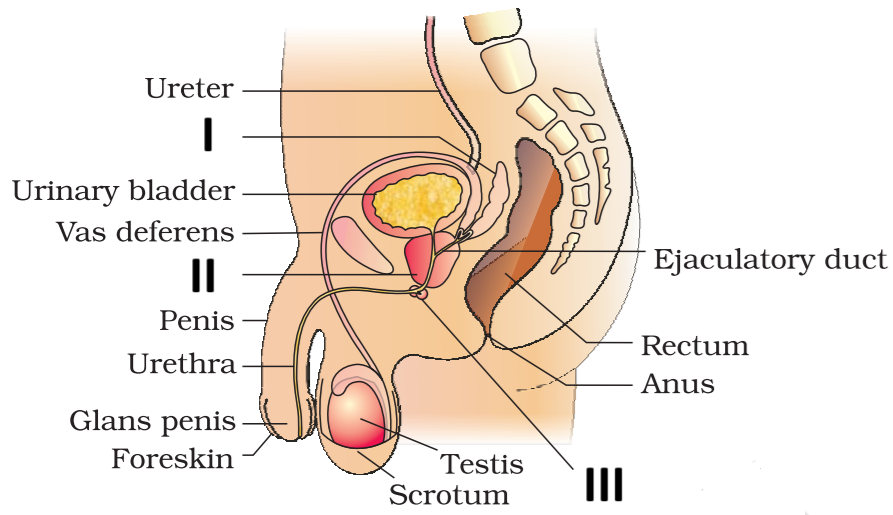
\(
\begin{array}{|l|l|}
\hline A . & \text { I contributes acidic fluid to the seminal plasma. } \\
\hline B . & \text { II is an unpaired gland. } \\
\hline C . & \text { III stores sperms. } \\
\hline
\end{array}
\)CorrectIncorrectHint
(a)
Statement 1: “I contributes acidic fluid to the seminal plasma.”
- ❌ Incorrect.
- According to NCERT, the prostate gland (which is I) secretes a slightly alkaline fluid that activates the sperms and helps in their motility.
- Seminal plasma is mainly composed of secretions from the seminal vesicles, prostate gland, and bulbourethral glands.
- So, it contributes alkaline, not acidic, fluid.
- Statement 2: “II is an unpaired gland.”
- ✅ Correct.
II: is the urinary bladder, which is a single (unpaired) muscular organ.
- Though not a gland, the question might be loosely phrased. If they intended prostate gland (below bladder), it is also unpaired.
- But from the labeled diagram, II is clearly the urinary bladder, and it’s unpaired.
Statement 3: “III stores sperms.”
- ❌ Incorrect.
- III is the testis, which produces sperms, but does not store them.
- According to NCERT, sperms are stored in the epididymis, which lies over the testis (not shown here explicitly).
-
Question 3 of 50
3. Question
1 point(s)Which of the statements is correct ?
CorrectIncorrectHint
(d)
-
Question 4 of 50
4. Question
1 point(s)Fill up the blanks –
After one month of pregnancy, the embryo’ A is formed. By the end of the B month of pregnancy, the foetus develops limbs and digits. By the end of C most of the major organ systems are formed, for example, the limbs and external genital organs are well-developed. By the end of D the body is covered with fine hair, eye-lids separate, and eyelashes are formedCorrectIncorrectHint
(a)
-
Question 5 of 50
5. Question
1 point(s)Which of the following does NOT occur during implantation ?
CorrectIncorrectHint
(d)
-
Question 6 of 50
6. Question
1 point(s)FSH in males :-
CorrectIncorrectHint
(c)
The correct answer is:
(c) Acts on Sertoli cells that help in spermiogenesis
Explanation:
- FSH (Follicle Stimulating Hormone) in males:
- Targets Sertoli cells in the seminiferous tubules of the testes.
- Supports spermatogenesis by stimulating Sertoli cells to produce factors essential for sperm development (spermiogenesis is the final stage of spermatogenesis).
Why the others are incorrect:
- (a) Incorrect: Leydig cells are stimulated by LH (Luteinizing Hormone), not FSH, to secrete testosterone.
- (b) Incorrect: Secondary sexual characters are induced mainly by testosterone, not directly by FSH.
- (d) Incorrect: ICSH (Interstitial Cell Stimulating Hormone) is another name for LH in males, not FSH.
-
Question 7 of 50
7. Question
1 point(s)The following diagram refers to female reproductive system of human. Identify A to F –
 CorrectIncorrect
CorrectIncorrectHint
(a)
-
Question 8 of 50
8. Question
1 point(s)Identify Correct Statement :-
A. During fertilization, a sperm comes in contact with the zona pellucida layer and induces the changes in the membrane that block the entry of additional sperm.
B. The milk produced during initial few days of lactation is called Colostrum having antibodies.
C. In human beings, menstrual cycle ceases around 50 years of age. It is called menopause.
D. After one month of pregnancy major organ system are formed.CorrectIncorrectHint
(d)
By the end of 12 weeks (first trimester), most of the major organ systems are formed, for example, the limbs and External genital organs are well developed.
-
Question 9 of 50
9. Question
1 point(s)Hormones secreted by human placenta are:-
A. human chorionic gonadotrophin (hCG)
B. human placental lactogen (hPL)
C. estrogen and progesterone
D. RelaxinCorrectIncorrectHint
(c)
-
Question 10 of 50
10. Question
1 point(s)Following is the diagrammatic sectional view of mammary gland. Identify A, B, C and D –
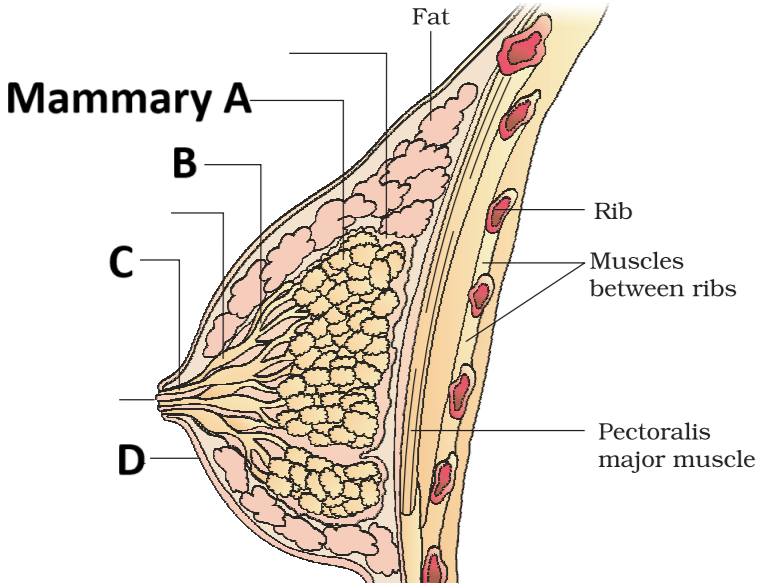 CorrectIncorrect
CorrectIncorrectHint
(b)
-
Question 11 of 50
11. Question
1 point(s)Fill up the blanks-
A functional mammary gland is characteristic of all female A . The mammary glands are paired structures (breasts) that contain glandular tissue and variable amount of fat. The glandular tissue of each breast is divided into 15-20 mammary lobes containing clusters of cells called ___B The cells of C___ secrete milk, which is stored in the cavities (lumens) of alveoli. The alveoli open into mammary tubules. The tubules of each lobe join to form a ____D_____ duct. Several E_____ ducts join to form a wider mammary ampulla which is connected to F duct through which milk is sucked out.CorrectIncorrectHint
(c)
-
Question 12 of 50
12. Question
1 point(s)The following diagram refers to female reproductive system of human. Identify A to E –
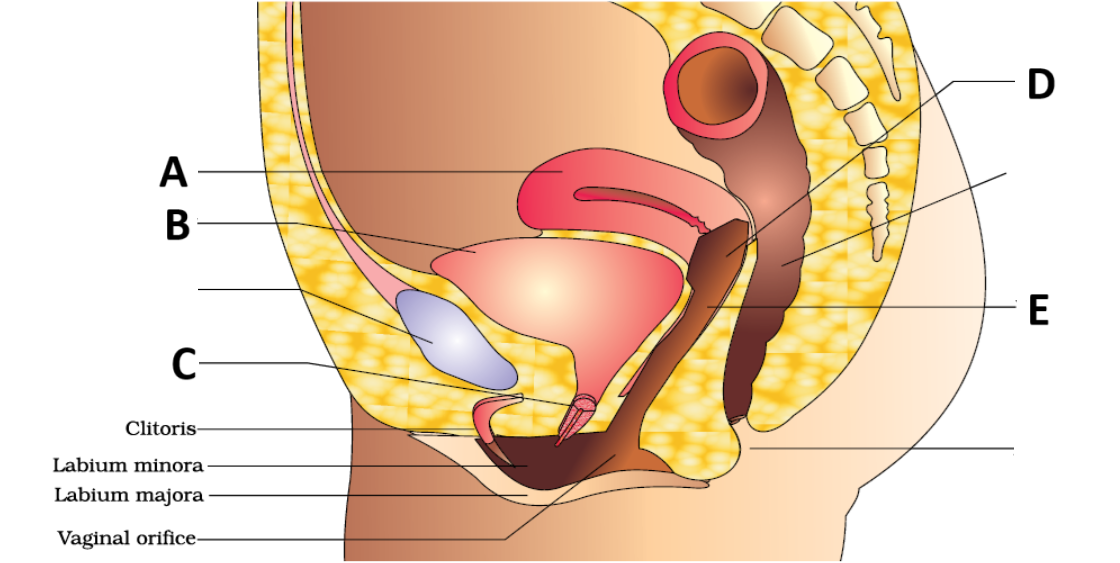 CorrectIncorrect
CorrectIncorrectHint
(d)
-
Question 13 of 50
13. Question
1 point(s)Given below is a statement with some blanks. Fill up the blanks correctly –
The male reproductive system consists of two testes. Each testis contains thin folded tubes called the A in which meiosis takes place to produce the male gametes, the sperms. These sperms move to the B (a highly coiled tube formed from the merging of the seminiferous tubules), and then to the C or sperm duct. The two vasa deferentia merge to form the urethra, which travels to the outside of the body through the penis.The cells located between the seminiferous tubules are called D cells and they are responsible for the formation of the male hormone, ECorrectIncorrectHint
(a)
-
Question 14 of 50
14. Question
1 point(s)Ovaries are the primary sex organs in human females because they:
I: Produce the female gamete.
II: Produce the hormone that regulates the development of secondary sexual characters.CorrectIncorrectHint
(a)
-
Question 15 of 50
15. Question
1 point(s)Consider the following two statements:
I: The hymen is often torn during the first coitus.
II: The presence or absence of hymen is a reliable indicator of virginity.Of the two Statements:-
CorrectIncorrectHint
(c)
II. The presence or abscence of Hymen is not a true indicator of Virginity
-
Question 16 of 50
16. Question
1 point(s)What causes the onset of puberty in males ?
CorrectIncorrectHint
(c)
-
Question 17 of 50
17. Question
1 point(s)Leydig cells synthesize androgens under the direct influence of :
CorrectIncorrectHint
(b)
-
Question 18 of 50
18. Question
1 point(s)FSH :-
CorrectIncorrectHint
(a)
-
Question 19 of 50
19. Question
1 point(s)At the birth of the female child, the follicles in her ovaries contain:
CorrectIncorrectHint
(b)
-
Question 20 of 50
20. Question
1 point(s)What happens to the majority of the follicles during the phase from birth to puberty ?
CorrectIncorrectHint
(c)
-
Question 21 of 50
21. Question
1 point(s)The division of primary oocyte results in:
CorrectIncorrectHint
(a)
-
Question 22 of 50
22. Question
1 point(s)The correct sequence of the various phases of a typical menstrual cycle is :
\(
\begin{array}{|r|l|}
\hline \text { 1. } & \text { Menstrual } \rightarrow \text { Follicular } \rightarrow \text { Secretory } \rightarrow \text { Ovulatory } \\
\hline \text { 2. } & \text { Menstrual } \rightarrow \text { Follicular } \rightarrow \text { Ovulatory } \rightarrow \text { Secretory } \\
\hline \text { 3. } & \text { Ovulatory } \rightarrow \text { Follicular } \rightarrow \text { Secretory } \rightarrow \text { Menstrual } \\
\hline \text { 4. } & \text { Menstrual } \rightarrow \text { Secretory } \rightarrow \text { Follicular } \rightarrow \text { Ovulatory } \\
\hline
\end{array}
\)CorrectIncorrectHint
(b)
-
Question 23 of 50
23. Question
1 point(s)Consider the following statements:
\(
\begin{array}{|l|l|}
\hline \text { I: } & \begin{array}{l}
\text { Menstruation only occurs if the released ovum is not } \\
\text { fertilized. }
\end{array} \\
\hline \text { II: } & \text { Lack of menstruation always indicates pregnancy. } \\
\hline
\end{array}
\)
Of the given statements, the correct statements is/are :CorrectIncorrectHint
(a)
-
Question 24 of 50
24. Question
1 point(s)During the follicular phase of the menstrual cycle which of the following occur ?
\(
\begin{array}{|l|l|}
\hline \text { I: } & \begin{array}{l}
\text { The primary follicle grows and becomes a fully } \\
\text { mature Graafian follicle. }
\end{array} \\
\hline \text { II: } & \begin{array}{l}
\text { The endometrium of the uterus regenerates through } \\
\text { proliferation. }
\end{array} \\
\hline
\end{array}
\)CorrectIncorrectHint
(c)
-
Question 25 of 50
25. Question
1 point(s)Changes in the ovary and the uterus, during the menstrual cycle, are induced by the changes in the levels of secretion of:
CorrectIncorrectHint
(c)
-
Question 26 of 50
26. Question
1 point(s)Given below are two statements : one is labelled as Assertion (A) and the other is labelled as Reason (R).
\(
\begin{array}{|l|l|}
\hline \text { Assertion (A): } & \begin{array}{l}
\text { LH is necessary to maintain luteal } \\
\text { function for the second two weeks of the } \\
\text { menstrual cycle. }
\end{array} \\
\hline \text { Reason (R): } & \begin{array}{l}
\text { If fertilization does not occur, LH is } \\
\text { continued to be secreted in low } \\
\text { concentration in the luteal phase. }
\end{array} \\
\hline
\end{array}
\)
In the light of the above statements, choose the most appropriate answer from the options given below :CorrectIncorrectHint
(c)
II :-
❌ Reason (R): False
“If fertilization does not occur, LH is continued to be secreted in low concentration in the luteal phase.”
- This is incorrect in its implication.
- In reality, LH levels fall significantly after ovulation and during the luteal phase if fertilization does not occur.
- The corpus luteum degenerates due to lack of LH support, especially as progesterone and estrogen levels rise, inhibiting further LH secretion via negative feedback on the hypothalamus and pituitary.
- The drop in LH (and FSH) causes the corpus luteum to regress, leading to menstruation.
-
Question 27 of 50
27. Question
1 point(s)During pregnancy:
CorrectIncorrectHint
(a)
-
Question 28 of 50
28. Question
1 point(s)In the absence of fertilization, Corpus Luteum :
CorrectIncorrectHint
(d)
-
Question 29 of 50
29. Question
1 point(s)Consider the following two statements :
\(
\begin{array}{|l|l|}
\hline \text { I: } & \text { Not all copulations lead to fertilization and pregnancy } \\
\hline \text { II: } & \begin{array}{l}
\text { Fertilization can occur if the ovum and the sperms are } \\
\text { simultaneously transported to the fallopian tubes. }
\end{array} \\
\hline
\end{array}
\)CorrectIncorrectHint
(a)
-
Question 30 of 50
30. Question
1 point(s)Cleavage is :
CorrectIncorrectHint
(d)
-
Question 31 of 50
31. Question
1 point(s)During embryonic development :
\(
\begin{array}{|l|l|}
\hline \text { 1. } & \begin{array}{l}
\text { the trophoblast cells help in the formation of the } \\
\text { placenta and inner cell mass differentiates into the } \\
\text { embryo }
\end{array} \\
\hline \text { 2. } & \begin{array}{l}
\text { the trophoblast cells differentiate into the embryo and } \\
\text { inner cell mass helps in the formation of the placenta }
\end{array} \\
\hline \text { 3. } & \begin{array}{l}
\text { the trophoblast cells help in the formation of the } \\
\text { placenta and both trophoblast cells and inner cell mass } \\
\text { differentiate into the embryo }
\end{array} \\
\hline \text { 4. } & \begin{array}{l}
\text { the trophoblast cells help in the formation of the } \\
\text { placenta and differentiate into the embryo as well }
\end{array} \\
\hline
\end{array}
\)CorrectIncorrectHint
(b)
-
Question 32 of 50
32. Question
1 point(s)Identify the correct statement:
\(
\begin{array}{|l|l|}
\hline \text { 1. } & \text { Sertoli cells help in spermiation } \\
\hline \text { 2. } & \text { The sperms are stored in seminal vesicles in humans } \\
\hline \text { 3. } & \begin{array}{l}
\text { Corpus Albicans secretes large amounts of } \\
\text { progesterone }
\end{array} \\
\hline \text { 4. } & \begin{array}{l}
\text { For normal fertility at least } 40 \% \text { sperms must show } \\
\text { vigorous motility }
\end{array} \\
\hline
\end{array}
\)CorrectIncorrectHint
(d)
I :
- Why it’s incorrect (NEET perspective):
- While Sertoli cells indeed help in spermiation (release of sperms from seminiferous tubules into the lumen), this point is not as central to fertility evaluation in NEET’s typical question framework.
- So although scientifically valid, it is not the best option among the four, given that option 4 aligns more with fertility standards, which NEET often emphasizes.
II :
- Why it’s incorrect (NEET perspective):
- NEET emphasizes basic reproductive anatomy.
- Sperms are not stored in seminal vesicles.
- Correct site of sperm storage: Epididymis, where sperm also mature.
- Seminal vesicles only secrete a fluid rich in fructose that nourishes sperm and contributes to semen volume — they do not store sperm.
III :
- Why it’s incorrect (NEET perspective):
- NEET textbooks (e.g., NCERT) clearly state:
- Corpus luteum is the structure that secretes progesterone.
- If fertilization does not occur, the corpus luteum degenerates into the corpus albicans.
- The corpus albicans is a scar-like structure and is hormonally inactive.
-
Question 33 of 50
33. Question
1 point(s)Chose the correct chronological order in which the following cells are produced :
\(
\begin{array}{|l|l|}
\hline \text { a. } & \text { primary spermatocytes } \\
\hline \text { b. } & \text { secondary spermatocytes } \\
\hline \text { c. } & \text { spermatids } \\
\hline \text { d. } & \text { spermatogonia } \\
\hline \text { e. } & \text { sperm cells } \\
\hline
\end{array}
\)CorrectIncorrectHint
(d)
-
Question 34 of 50
34. Question
1 point(s)LH surge:-
CorrectIncorrectHint
(d)
-
Question 35 of 50
35. Question
1 point(s)The ducts of the seminal vesicles in humans :
CorrectIncorrectHint
(a)
-
Question 36 of 50
36. Question
1 point(s)An oocyte is released from the ovary under the influence of LH :
CorrectIncorrectHint
(d)
-
Question 37 of 50
37. Question
1 point(s)Read the given statements carefully
(a) Secondary oocyte is diploid.
(b) Human male ejaculates about 200 to 300 million sperms during a coitus.
(c) FSH acts on the Sertoli cells and stimulates secretion of some factors which help in the process of spermiogenesis.
(d) For normal fertility at least \( 60 \% \) sperms must have normal shape and size and \( 40 \% \) of them must show vigorous motility.How many of above statement/s is/are correct ?
CorrectIncorrectHint
(b)
Statement (a) is wrong
Statement (a):
“Secondary oocyte is diploid.”
❌ Incorrect-
The secondary oocyte is haploid (n) — it is formed after first meiotic division of the primary oocyte (which is diploid, 2n).
-
It carries 23 chromosomes, not 46
-
Question 38 of 50
38. Question
1 point(s)The following belongs to human sperm. Identify A, B and C.
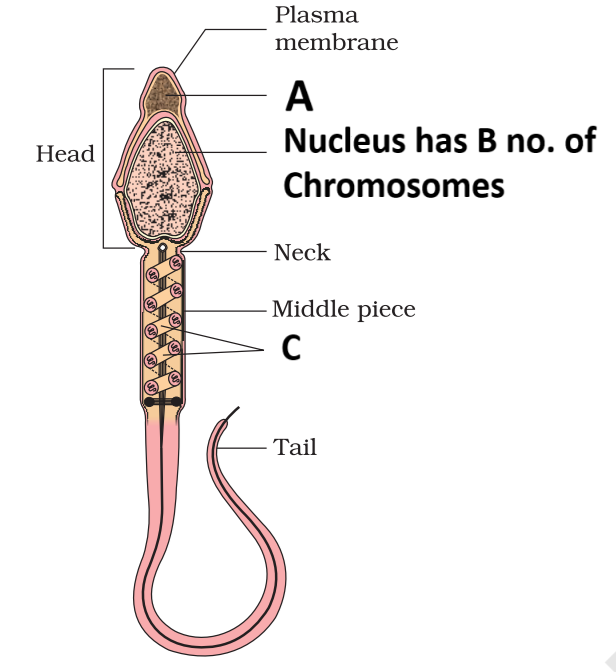 CorrectIncorrect
CorrectIncorrect -
Question 39 of 50
39. Question
1 point(s)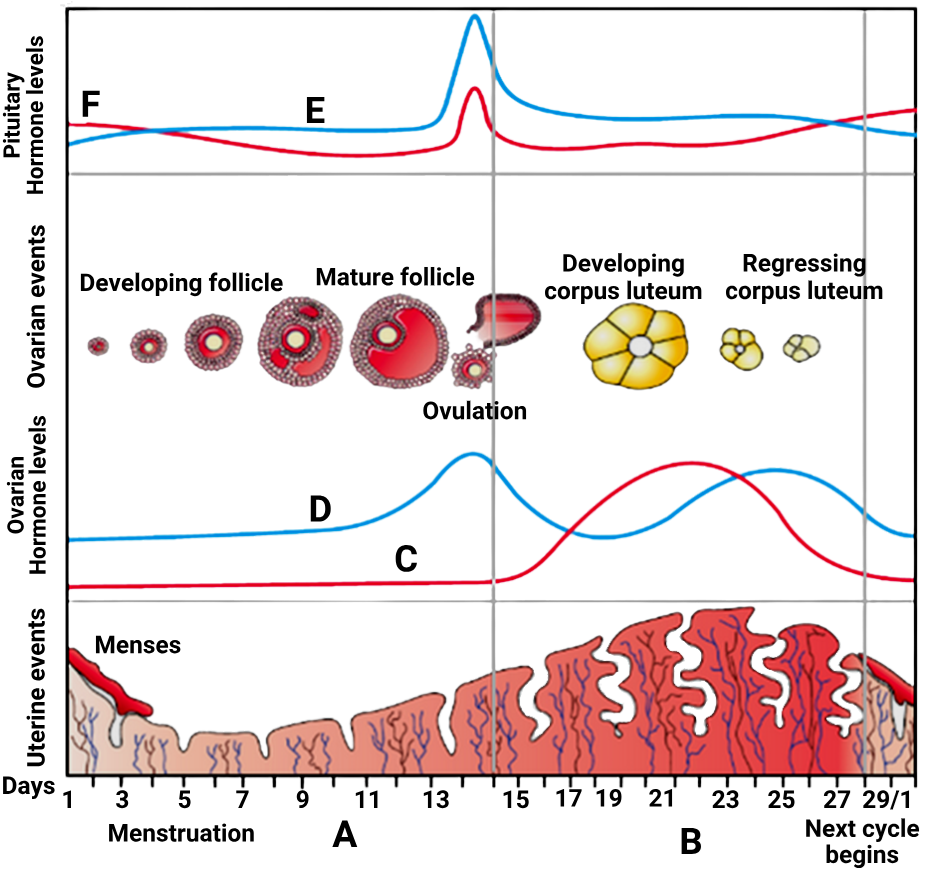
Identify the correct statements :
\(
\begin{array}{|l|l|}
\hline \begin{array}{l}
\text { Statement } \\
\text { I: }
\end{array} & \begin{array}{l}
\text { A is also called as secretory phase and is the } \\
\text { phase of the menstrual cycle where the follicl } \\
\text { matures into a Graafian follicle. }
\end{array} \\
\hline \begin{array}{l}
\text { Statement } \\
\text { II: }
\end{array} & \begin{array}{l}
\text { B is the luteal phase and is the phase when } \\
\text { the uterine endometrium regenerates through }
\end{array} \\
\hline
\end{array}
\)CorrectIncorrectHint
(d)
Diagram Sections:
-
A (Days 6–14) = Follicular phase / Proliferative phase
-
B (Days 15–28) = Luteal phase / Secretory phase
I : Wrong name given for phase A:
- A = Follicular phase (not secretory phase!)
- This is the time when follicle develops into a mature (Graafian) follicle — that part is correct.
- But since A is wrongly called the secretory phase,
❌ Statement I is incorrect.
II : Wrong function assigned to phase B:
- B = Luteal phase, yes.
- But in this phase, the endometrium thickens further and becomes highly vascularized and glandular — this is called the secretory phase of the uterine cycle.
- Proliferation occurs earlier during the follicular phase (A).
- ❌ Statement II is incorrect.
-
Question 40 of 50
40. Question
1 point(s)Read the following statements
A. FSH inhibits spermatogenesis
B. Vasectomy (i.e. removal of vas deferens) prevents sperm transport
C. Blocking of vasa efferentia prevents sperm transport to epididymis
D. Ejaculatory duct is a part of intra-testicular ductal systemHow many of above statements are true ?
CorrectIncorrectHint
(b)
Two statements are wrong and two statements are right
Statement A:
FSH inhibits spermatogenesis
❌ False-
FSH (Follicle Stimulating Hormone) stimulates spermatogenesis by acting on Sertoli cells. It does not inhibit it.
Statement D:
Ejaculatory duct is a part of intra-testicular ductal system
❌ False-
The ejaculatory duct is outside the testis; it is part of the ductal system in the male reproductive tract but external to the testis.
-
The intra-testicular ducts include the seminiferous tubules, rete testis, and vasa efferentia.
-
Question 41 of 50
41. Question
1 point(s)What would be true for the figure given below ?

\(
\begin{array}{|l|l|}
\hline \text { I. } & \text { A prevents polyspermy. } \\
\hline \text { II. } & \text { B is the space where the polar body is released. } \\
\hline \text { III. } & \text { Cells in this region secrete progesterone. } \\
\hline
\end{array}
\)CorrectIncorrectHint
(b)
A – Zona pellucida
B – Perivitelline space (space between zona pellucida and plasma membrane, where polar body is present)
C – Corona radiata (outermost granulosa cell layer)III. Cells in this region secrete progesterone.
- Incorrect.
- The cells around the ovum in the diagram (corona radiata) do not secrete progesterone.
- Progesterone is secreted by the corpus luteum in the ovary after ovulation.
-
Question 42 of 50
42. Question
1 point(s)Given below is the diagram of a male reproductive system. In which one of the options all the five parts A, B, C, D and E are correct ?
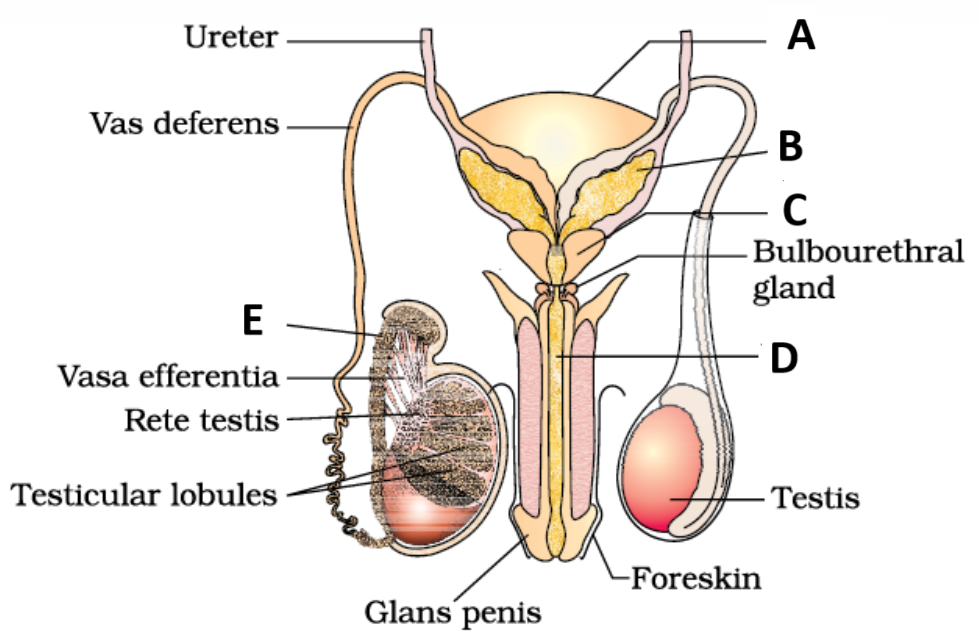 CorrectIncorrect
CorrectIncorrectHint
(b)
-
Question 43 of 50
43. Question
1 point(s)In the diagrammatic sectional view of the seminiferous tubule, which structures shown in the diagram are correctly matched to the description given ?
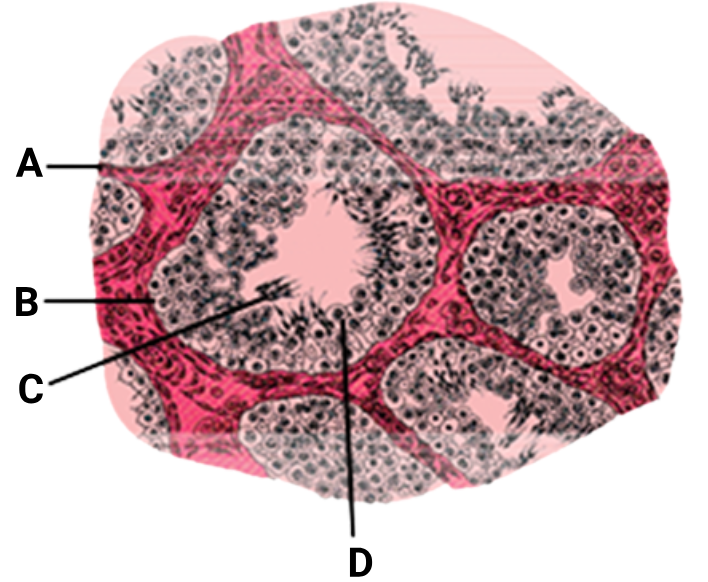
\(
\begin{array}{|c|l|}
\hline \text { A. } & \begin{array}{l}
\text { the primary source of testosterone or androgens in } \\
\text { males }
\end{array} \\
\hline \text { B. } & \begin{array}{l}
\text { male germ cells in the inside lining of seminiferous } \\
\text { tubules }
\end{array} \\
\hline \text { C. } & \text { spermatids released from seminiferous tubules } \\
\hline \text { D. } & \begin{array}{l}
\text { Present in the inside lining of seminiferous tubules, } \\
\text { they nourish developing sperm cells }
\end{array} \\
\hline
\end{array}
\)CorrectIncorrectHint
(b)
Label A 📌 Identity: Interstitial (Leydig) Cells
Label B 📌 Identity: Spermatogonia (Male Germ Cells)
Label C 📌 Identity: Spermatids
Label D 📌 Identity: Sertoli Cells
Label C
📌 Identity: Spermatids
-
Location: Near the lumen of seminiferous tubules, more mature than spermatocytes.
-
Function (NCERT): Result from meiosis II of secondary spermatocytes; they undergo spermiogenesis to become spermatozoa.
-
Description Given: “Spermatids released from seminiferous tubules”
❌ Match? Partially correct identity (they are spermatids), but description is wrong.
❌ Function correct? No — spermatids are not released; they are transformed into spermatozoa, which are then released via spermiation.
-
Question 44 of 50
44. Question
1 point(s)In the given diagrammatic sectional view of a seminiferous tubule, cells that nourish developing sperms and the cells that undergo reduction division are respectively represented by the letters :
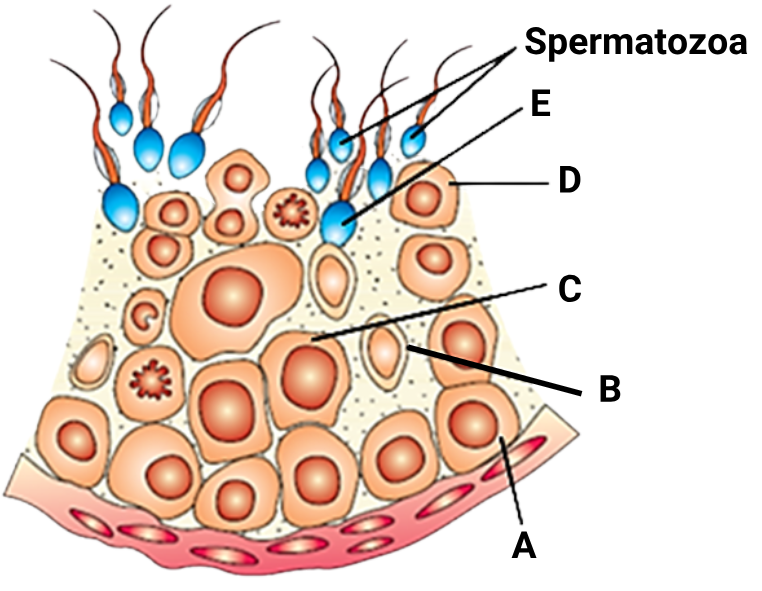 CorrectIncorrect
CorrectIncorrectHint
(a)
- A – Spermatogonia (diploid stem cells)
- B – Primary spermatocytes
- C – Sertoli cells
- D – Spermatids
- E – Spermatozoa
“Cells that nourish developing sperms” → Sertoli cells → C
“Cells that undergo reduction division” → Primary spermatocytes → B -
Question 45 of 50
45. Question
1 point(s)Identify the parts labelled (A to G) in the diagram of male reproductive system from the list I to X given along with..
I. Fundus
II. Uriniferous tubules
III. Seminiferous tubules
IV. Seminal vesicle
V. Prostate
VI. Ejaculatory duct
VII. Rectum
VIII.Anus
IX Bulbourethral gland
X Scrotum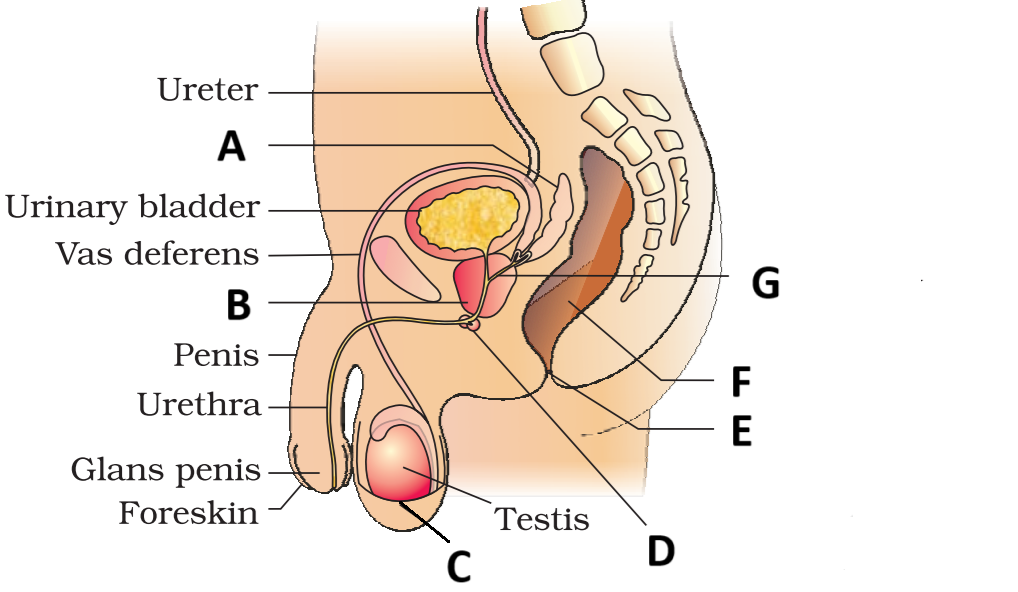 CorrectIncorrect
CorrectIncorrectHint
(c)
-
Question 46 of 50
46. Question
1 point(s)
Identify the correct statements:
\(
\begin{array}{|l|l|}
\hline \begin{array}{l}
\text { Statement } \\
\text { I: }
\end{array} & \begin{array}{l}
\text { C is secreted in large amounts by the corpus } \\
\text { luteum and is called the pregnancy hormone. }
\end{array} \\
\hline \text { Statement } & \text { D is responsible for the development of } \\
\text { II: } & \text { secondary sexual characters in females. } \\
\hline
\end{array}
\)CorrectIncorrect -
Question 47 of 50
47. Question
1 point(s)In the schematic representation of gametogenesis in humans, what will be the correct description for A–E ?
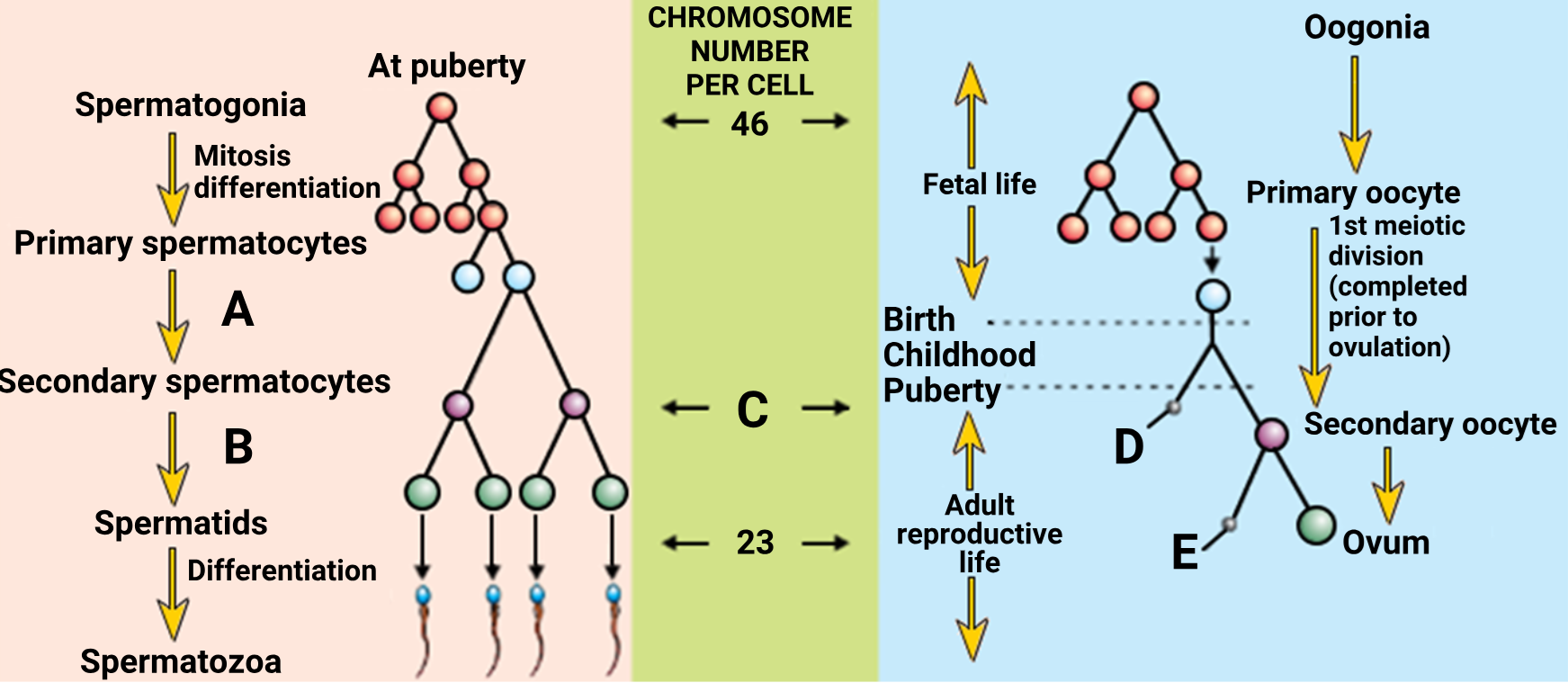
\(
\begin{array}{|c|c|c|c|c|c|}
\hline
& \textbf{A} & \textbf{B} & \textbf{C} & \textbf{D} & \textbf{E} \\
\hline
1. & \begin{array}{c}
\text{First} \\
\text{meiotic} \\
\text{division}
\end{array}
& \begin{array}{c}
\text{Second} \\
\text{meiotic} \\
\text{division}
\end{array}
& 23
& \begin{array}{c}
\text{First} \\
\text{polar} \\
\text{body}
\end{array}
& \begin{array}{c}
\text{Second} \\
\text{polar} \\
\text{body}
\end{array} \\
\hline
2. & \begin{array}{c}
\text{Mitosis and} \\
\text{differentiation}
\end{array}
& \begin{array}{c}
\text{First} \\
\text{meiotic} \\
\text{division}
\end{array}
& 23
& \begin{array}{c}
\text{First} \\
\text{polar} \\
\text{body}
\end{array}
& \begin{array}{c}
\text{Secondary} \\
\text{polar} \\
\text{body}
\end{array} \\
\hline
3. & \begin{array}{c}
\text{First} \\
\text{meiotic} \\
\text{division}
\end{array}
& \begin{array}{c}
\text{Second} \\
\text{meiotic} \\
\text{division}
\end{array}
& 46
& \begin{array}{c}
\text{First} \\
\text{polar} \\
\text{body}
\end{array}
& \begin{array}{c}
\text{Second} \\
\text{polar} \\
\text{body}
\end{array} \\
\hline
4. & \begin{array}{c}
\text{Mitosis and} \\
\text{differentiation}
\end{array}
& \begin{array}{c}
\text{First} \\
\text{meiotic} \\
\text{division}
\end{array}
& 46
& \begin{array}{c}
\text{First} \\
\text{polar} \\
\text{body}
\end{array}
& \begin{array}{c}
\text{Secondary} \\
\text{polar} \\
\text{body}
\end{array} \\
\hline
\end{array}
\)CorrectIncorrectHint
(a)
-
Question 48 of 50
48. Question
1 point(s)
Identify the correct statements :
\(
\begin{array}{|l|l|}
\hline \begin{array}{l}
\text { Statement } \\
\text { I: }
\end{array} & \begin{array}{l}
\text { The dramatic increase in } \mathrm{E} \text { is responsible for } \\
\text { ovulation. }
\end{array} \\
\hline \begin{array}{l}
\text { Statement } \\
\text { II: }
\end{array} & \begin{array}{l}
\text { F makes the uterine endometrium highly } \\
\text { nutritive and ready for the implantation of the } \\
\text { blastocyst. }
\end{array} \\
\hline
\end{array}
\)CorrectIncorrectHint
(a)
-
E (blue curve in pituitary hormones section) = LH (Luteinizing Hormone)
-
F (red curve in pituitary hormones section) = FSH (Follicle Stimulating Hormone)
❌ Statement II:
“F makes the uterine endometrium highly nutritive and ready for implantation of the blastocyst.”
-
F = FSH
-
FSH’s main role is:
-
Stimulate follicular development in the ovary.
-
Slightly promotes estrogen secretion.
-
-
It does not directly act on the uterus.
-
Progesterone (ovarian hormone C) is mainly responsible for making the endometrium highly vascular and glandular, preparing it for implantation.
❌ Statement II is incorrect.
-
Question 49 of 50
49. Question
1 point(s)Identify the statements as true or false
I. Menstruation is due to decline in progesterone level
II. Prostate is unpaired gland.
III. Bulbo-urethral gland is an unpaired gland
IV. Acrosome contains enzymes that help in fertilization of ovum.
\(
\begin{array}{|c|c|c|c|c|}
\hline & \mathrm{I} & \mathrm{II} & \mathrm{III} & \mathrm{IV} \\
\hline(1) & \mathrm{T} & \mathrm{~T} & \mathrm{~T} & \mathrm{~F} \\
\hline(2) & \mathrm{T} & \mathrm{~F} & \mathrm{~T} & \mathrm{~T} \\
\hline(3) & \mathrm{T} & \mathrm{~T} & \mathrm{~F} & \mathrm{~T} \\
\hline(4) & \mathrm{T} & \mathrm{~T} & \mathrm{~T} & \mathrm{~T} \\
\hline
\end{array}
\)CorrectIncorrectHint
(c)
Bulbourethral Gland is Paird Gland
-
Question 50 of 50
50. Question
1 point(s)Find out the incorrect match with respect to structure and the hormone produced from it
CorrectIncorrectHint
(d)
(4) Leydig cells – Progesterone ❌
-
❌ Incorrect match
-
Leydig (interstitial) cells secrete androgens, mainly testosterone, not progesterone.
-
Progesterone is secreted by corpus luteum and placenta, not by Leydig cells.